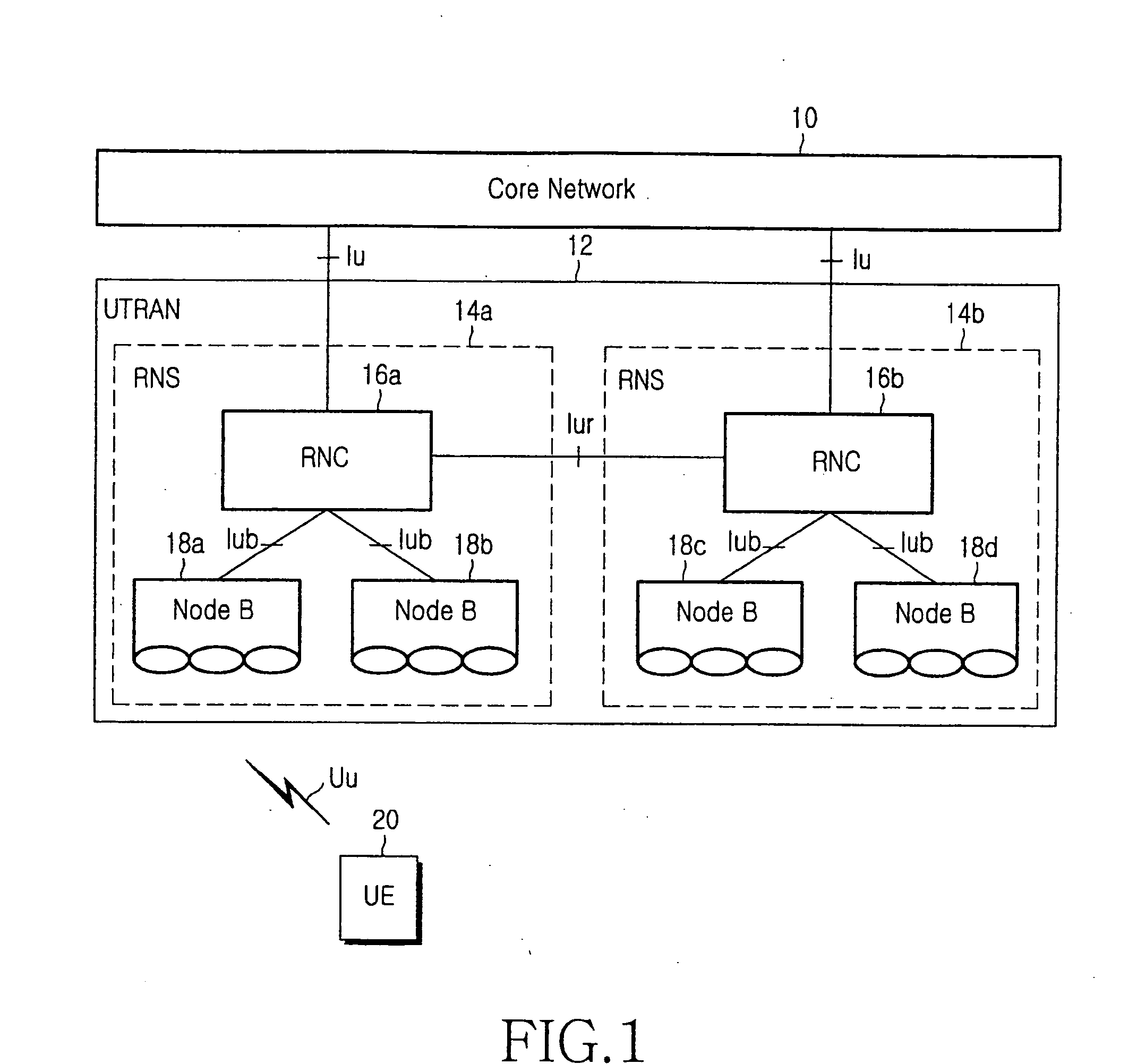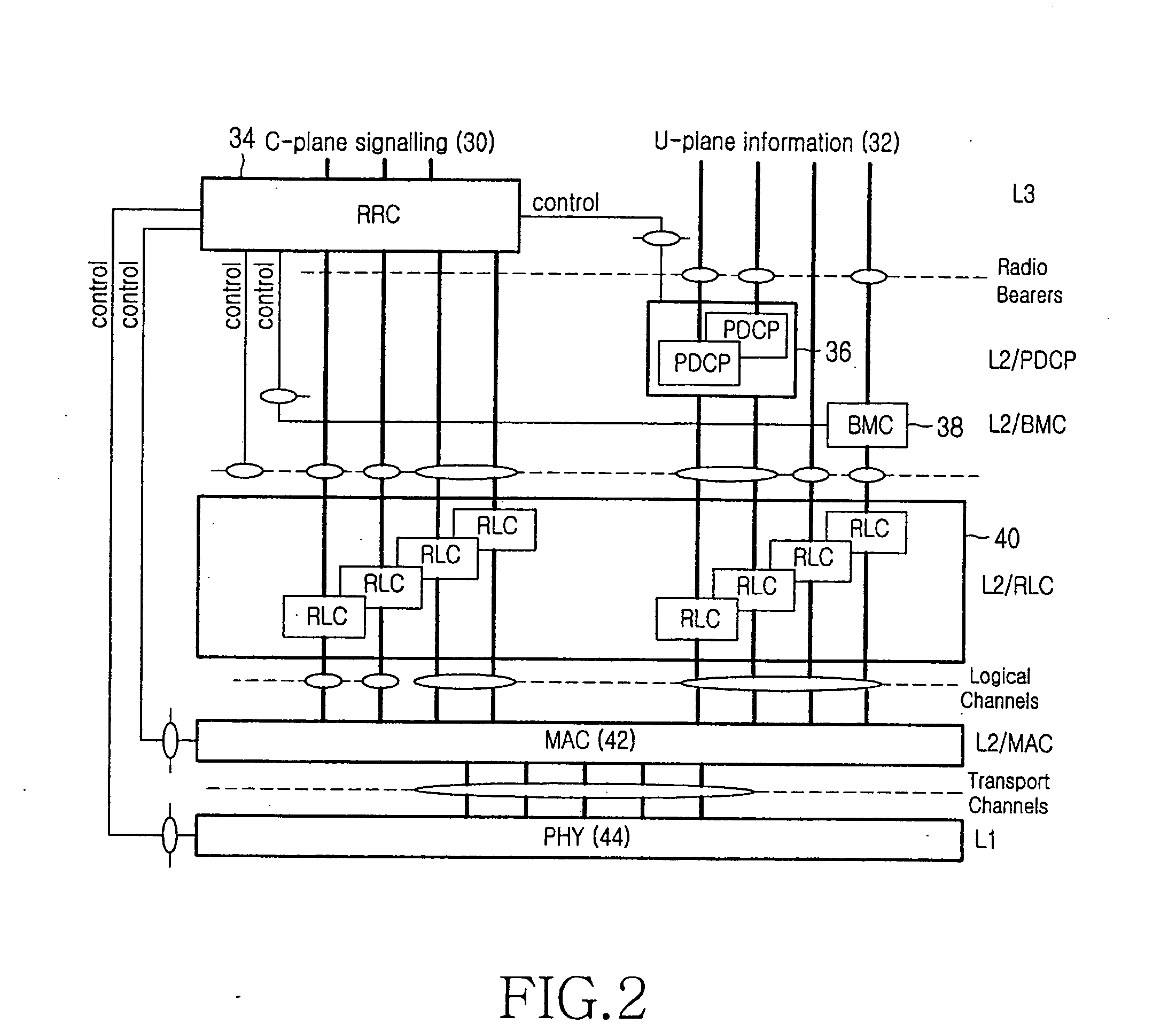Method and apparatus for scheduling uplink data transmission for mobile station in soft handover region in a mobile communication system
a mobile communication system and mobile station technology, applied in electrical apparatus, network traffic/resource management, wireless commuication services, etc., can solve problems such as difficulty in deciding e-dch transmission, and achieve the effect of efficient scheduling e-dch transmission
- Summary
- Abstract
- Description
- Claims
- Application Information
AI Technical Summary
Benefits of technology
Problems solved by technology
Method used
Image
Examples
first exemplary embodiment
[0061] A UE located in a soft handover region receives a dedicated scheduling grant from a serving Node B and an overload bit as a common scheduling grant from a non-serving Node B. If the overload bit is “0”, the UE determines an uplink data rate based on the dedicated scheduling grant. If the overload bit is “1”, the UE does not increase the uplink data rate during a predetermined validity duration.
[0062] That is, the UE, receiving the overload bit from the non-serving Node B, operates considering the overload bit rather than based on the dedicated scheduling grant from the serving Node B. More specifically, the UE does not set a rate request bit to “UP” to prevent the uplink rate of the next TTI from exceeding that of the current TTI. A validity duration for which the rate request bit is supposed not to be set to “UP” is a fixed value or notified by an RNC.
[0063]FIG. 6 is a diagram illustrating signaling for transmission / reception of validity duration information between an RNC...
second exemplary embodiment
[0074] A UE located in a soft handover region receives an overload bit as a common scheduling grant from a non-serving Node B and a dedicated scheduling grant from a serving Node B, for allocation of uplink resources. If the overload bit is not set to 1, the UE allocates uplink resources according to whether current uplink data is to be initially transmitted or retransmitted. If the non-serving Node B is overloaded and the uplink data is to be initially transmitted, the UE sets a rate request bit to a non-“UP” value, neglecting the dedicated scheduling grant.
[0075]FIG. 8 is a flowchart illustrating an operation for transmitting uplink data based on validity duration information in the UE according to another exemplary embodiment of the present invention. The UE considers whether uplink data is to be initially transmitted or retransmitted in determining the data rate of the uplink data.
[0076] Referring to FIG. 8, the UE is located in a soft handover region in step 801. In step 802,...
third exemplary embodiment
[0080] A UE is located in a soft handover region. The UE receives an overload bit as a common scheduling grant from a non-serving Node B in an active set and a dedicated scheduling grant from a serving Node B in the active set.
[0081] If the overload bit is 0, the UE allocates uplink resources based on the dedicated scheduling grant. If the overload bit is 1, the UE operates in the following limited manner.
[0082] For the overload bit being 1 indicating the overload of the non-serving Node B, the UE sets a rate request bit to a non-“UP” value and operates for the earliest coming initial transmission in a predetermined method. For example, the UE uses a data rate one level lower than the dedicated scheduling grant allows, or one level lower than the previous data rate.
[0083] In accordance with the third exemplary embodiment of the present invention, an RNC notifies the serving Node B of the validity duration of the overload bit and the serving Node B controls the UE to use a data ra...
PUM
 Login to View More
Login to View More Abstract
Description
Claims
Application Information
 Login to View More
Login to View More - R&D
- Intellectual Property
- Life Sciences
- Materials
- Tech Scout
- Unparalleled Data Quality
- Higher Quality Content
- 60% Fewer Hallucinations
Browse by: Latest US Patents, China's latest patents, Technical Efficacy Thesaurus, Application Domain, Technology Topic, Popular Technical Reports.
© 2025 PatSnap. All rights reserved.Legal|Privacy policy|Modern Slavery Act Transparency Statement|Sitemap|About US| Contact US: help@patsnap.com



